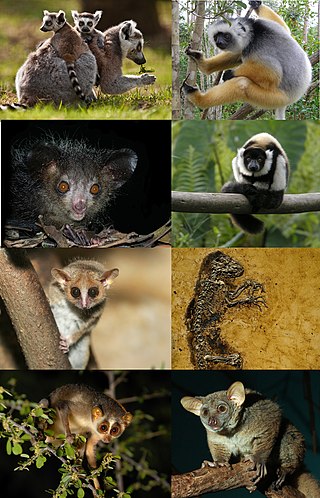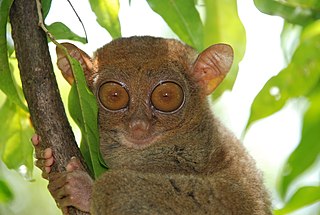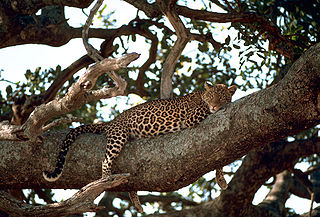Related Research Articles

Bipedalism is a form of terrestrial locomotion where an animal moves by means of its two rear limbs or legs. An animal or machine that usually moves in a bipedal manner is known as a biped, meaning 'two feet'. Types of bipedal movement include walking or running and hopping.

Primates is an order of mammals, which is further divided into the strepsirrhines, which include lemurs, galagos, and lorisids; and the haplorhines, which include tarsiers and simians. Primates arose 74–63 million years ago first from small terrestrial mammals, which adapted for life in tropical forests: many primate characteristics represent adaptations to the challenging environment among tree tops, including large brain sizes, binocular vision, color vision, vocalizations, shoulder girdles allowing a large degree of movement in the upper limbs, and opposable thumbs that enable better grasping and dexterity. Primates range in size from Madame Berthe's mouse lemur, which weighs 30 g (1 oz), to the eastern gorilla, weighing over 200 kg (440 lb). There are 376–524 species of living primates, depending on which classification is used. New primate species continue to be discovered: over 25 species were described in the 2000s, 36 in the 2010s, and six in the 2020s.

Night monkeys, also known as owl monkeys or douroucoulis, are nocturnal New World monkeys of the genus Aotus, the only member of the family Aotidae. The genus comprises eleven species which are found across Panama and much of South America in primary and secondary forests, tropical rainforests and cloud forests up to 2,400 metres (7,900 ft). Night monkeys have large eyes which improve their vision at night, while their ears are mostly hidden, giving them their name Aotus, meaning "earless".

An eye is a sensory organ that allows an organism to perceive visual information. It detects light and converts it into electro-chemical impulses in neurons (neurones). It is part of an organism's visual system.

Depth perception is the ability to perceive distance to objects in the world using the visual system and visual perception. It is a major factor in perceiving the world in three dimensions.

Strepsirrhini or Strepsirhini is a suborder of primates that includes the lemuriform primates, which consist of the lemurs of Madagascar, galagos ("bushbabies") and pottos from Africa, and the lorises from India and southeast Asia. Collectively they are referred to as strepsirrhines. Also belonging to the suborder are the extinct adapiform primates which thrived during the Eocene in Europe, North America, and Asia, but disappeared from most of the Northern Hemisphere as the climate cooled. Adapiforms are sometimes referred to as being "lemur-like", although the diversity of both lemurs and adapiforms does not support this comparison.

Prosimians are a group of primates that includes all living and extinct strepsirrhines, as well as the haplorhine tarsiers and their extinct relatives, the omomyiforms, i.e. all primates excluding the simians. They are considered to have characteristics that are more "primitive" than those of simians.

Lemurs are wet-nosed primates of the superfamily Lemuroidea, divided into 8 families and consisting of 15 genera and around 100 existing species. They are endemic to the island of Madagascar. Most existing lemurs are small, have a pointed snout, large eyes, and a long tail. They chiefly live in trees and are active at night.

Brachiation, or arm swinging, is a form of arboreal locomotion in which primates swing from tree limb to tree limb using only their arms. During brachiation, the body is alternately supported under each forelimb. This form of locomotion is the primary means of locomotion for the small gibbons and siamangs of southeast Asia. Gibbons in particular use brachiation for as much as 80% of their locomotor activities. Some New World monkeys, such as spider monkeys and muriquis, were initially classified as semibrachiators and move through the trees with a combination of leaping and brachiation. Some New World species also practice suspensory behaviors by using their prehensile tail, which acts as a fifth grasping hand. Evidence has shown that the extinct ape Proconsul from the Miocene of East Africa developed an early form of suspensory behaviour, and was therefore referred to as a probrachiator.

Knuckle-walking is a form of quadrupedal walking in which the forelimbs hold the fingers in a partially flexed posture that allows body weight to press down on the ground through the knuckles. Gorillas and chimpanzees use this style of locomotion, as do anteaters and platypuses.
The postorbital bar is a bony arched structure that connects the frontal bone of the skull to the zygomatic arch, which runs laterally around the eye socket. It is a trait that only occurs in mammalian taxa, such as most strepsirrhine primates and the hyrax, while haplorhine primates have evolved fully enclosed sockets. One theory for this evolutionary difference is the relative importance of vision to both orders. As haplorrhines tend to be diurnal, and rely heavily on visual input, many strepsirrhines are nocturnal and have a decreased reliance on visual input.

Arboreal locomotion is the locomotion of animals in trees. In habitats in which trees are present, animals have evolved to move in them. Some animals may scale trees only occasionally (scansorial), but others are exclusively arboreal. The habitats pose numerous mechanical challenges to animals moving through them and lead to a variety of anatomical, behavioral and ecological consequences as well as variations throughout different species. Furthermore, many of these same principles may be applied to climbing without trees, such as on rock piles or mountains.

The evolution of color vision in primates is highly unusual compared to most eutherian mammals. A remote vertebrate ancestor of primates possessed tetrachromacy, but nocturnal, warm-blooded, mammalian ancestors lost two of four cones in the retina at the time of dinosaurs. Most teleost fish, reptiles and birds are therefore tetrachromatic while most mammals are strictly dichromats, the exceptions being some primates and marsupials, who are trichromats, and many marine mammals, who are monochromats.

Visual perception in animals plays an important role in the animal kingdom, most importantly for the identification of food sources and avoidance of predators. For this reason, blindness in animals is a unique topic of study.
Vertical clinging and leaping (VCL) is a type of arboreal locomotion seen most commonly among the strepsirrhine primates and haplorrhine tarsiers. The animal begins at rest with its torso upright and elbows fixed, with both hands clinging to a vertical support, such as the side of a tree or bamboo stalk. To move from one support to another, it pushes off from one vertical support with its hindlimbs, landing on another vertical support after an extended period of free flight. Vertical clinging and leaping primates have evolved a specialized anatomy to compensate for the physical implications of this form of locomotion. These key morphological specializations have been identified in prosimian fossils from as early as the Eocene.
Dinosaur vision was, in general, better than the vision of most other reptiles, although vision varied between dinosaur species. Coelurosaurs, for example, had good stereoscopic or binocular vision, whereas large carnosaurs had poor binocular vision, comparable to that of modern alligators. Recent evidence has also shown that some species possessed highly specialized color and night vision.
Evolutionary aesthetics refers to evolutionary psychology theories in which the basic aesthetic preferences of Homo sapiens are argued to have evolved in order to enhance survival and reproductive success.

The evolutionary history of the primates can be traced back 57-90 million years. One of the oldest known primate-like mammal species, Plesiadapis, came from North America; another, Archicebus, came from China. Other similar basal primates were widespread in Eurasia and Africa during the tropical conditions of the Paleocene and Eocene. Purgatorius is the genus of the four extinct species believed to be the earliest example of a primate or a proto-primate, a primatomorph precursor to the Plesiadapiformes, dating to as old as 66 million years ago.

The following outline is provided as an overview of and topical guide to evolution:
Odor molecules are detected by the olfactory receptors in the olfactory epithelium of the nasal cavity. Each receptor type is expressed within a subset of neurons, from which they directly connect to the olfactory bulb in the brain. Olfaction is essential for survival in most vertebrates; however, the degree to which an animal depends on smell is highly varied. Great variation exists in the number of OR genes among vertebrate species, as shown through bioinformatic analyses. This diversity exists by virtue of the wide-ranging environments that they inhabit. For instance, dolphins that are secondarily adapted to an aquatic niche possess a considerably smaller subset of genes than most mammals. OR gene repertoires have also evolved in relation to other senses, as higher primates with well-developed vision systems tend to have a smaller number of OR genes. As such, investigating the evolutionary changes of OR genes can provide useful information on how genomes respond to environmental changes. Differences in smell sensitivity are also dependent on the anatomy of the olfactory apparatus, such as the size of the olfactory bulb and epithelium.
References
- ↑ Kennedy, G.E. Paleoanthroplogy (1980) New York: McGraw-Hill Book Company.(p.28)
- ↑ Sussman, Robert W. (1991). "Primate origins and the evolution of angiosperms". American Journal of Primatology. 23 (4): 209–223. doi:10.1002/ajp.1350230402. PMID 31952400.
- ↑ Cartmill, Matt (1974-04-26). "Rethinking Primate Origins: The characteristic primate traits cannot be explained simply as adaptations to arboreal life". Science. 184 (4135): 436–443. doi:10.1126/science.184.4135.436. ISSN 0036-8075. PMID 4819676.
- ↑ "Copyright", Primate Adaptation and Evolution, Elsevier, p. 4, 2013, doi:10.1016/b978-0-12-378632-6.02001-2, ISBN 978-0-12-378632-6 , retrieved 2024-04-17
- ↑ Swedell, Larissa (2012). "Primate Sociality and Social Systems". Nature. Retrieved April 17, 2024.
- ↑ Dewar, Robert E.; Richard, Alison F. (2007-08-21). "Evolution in the hypervariable environment of Madagascar". Proceedings of the National Academy of Sciences. 104 (34): 13723–13727. Bibcode:2007PNAS..10413723D. doi: 10.1073/pnas.0704346104 . ISSN 0027-8424. PMC 1947998 . PMID 17698810.